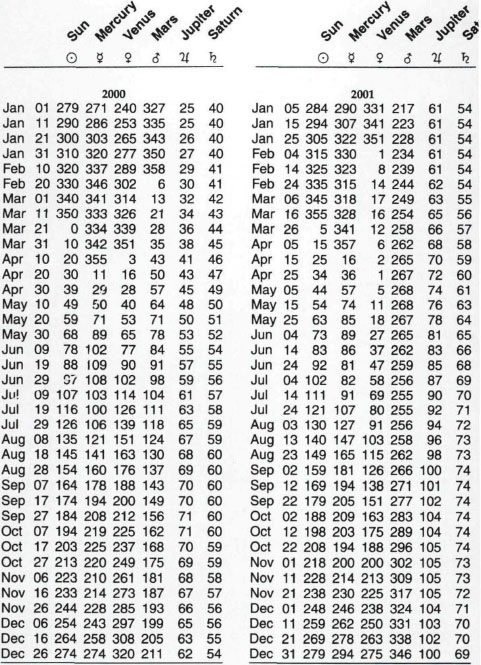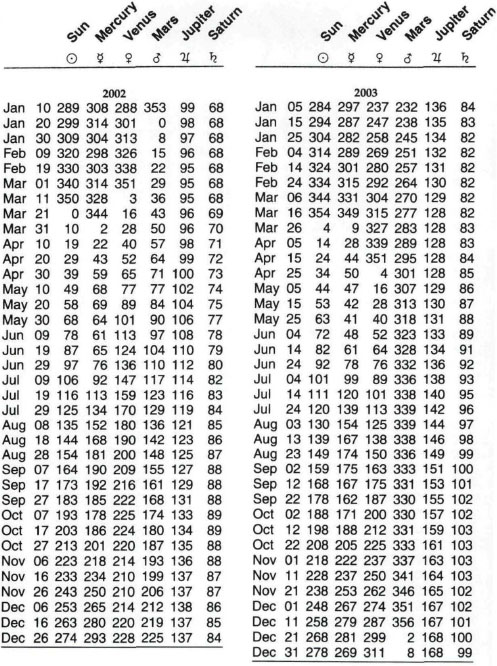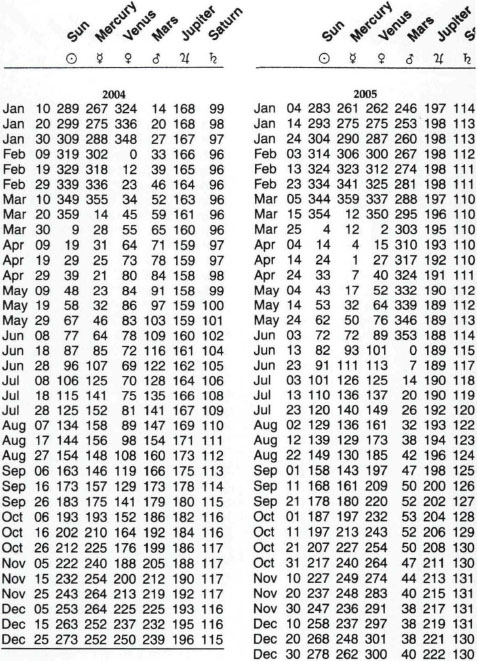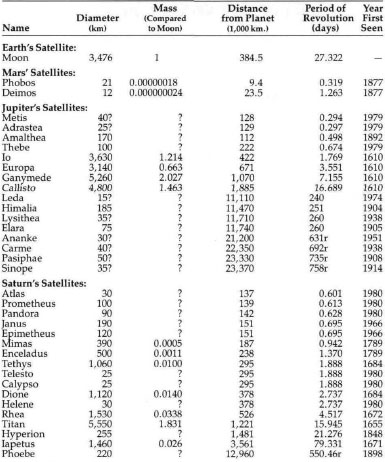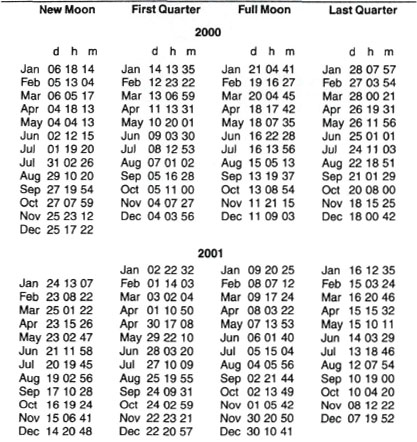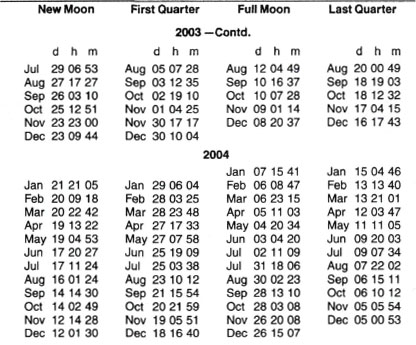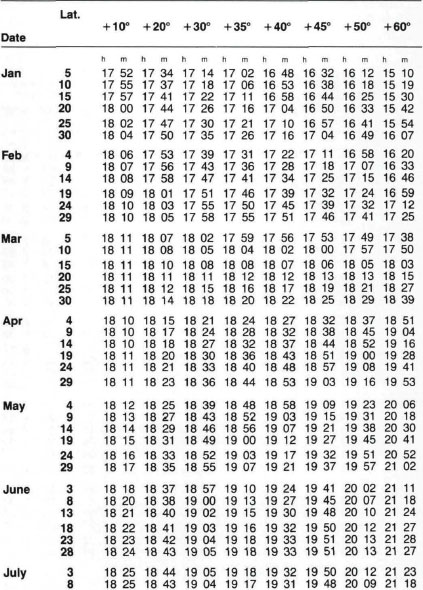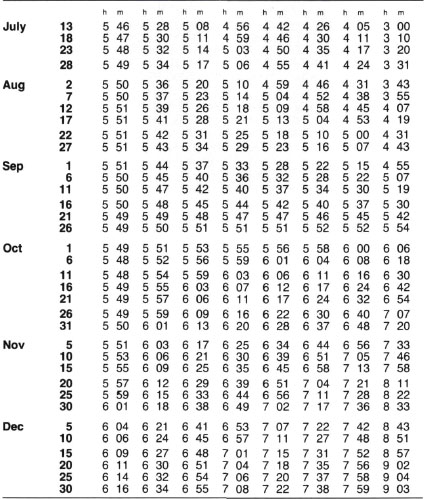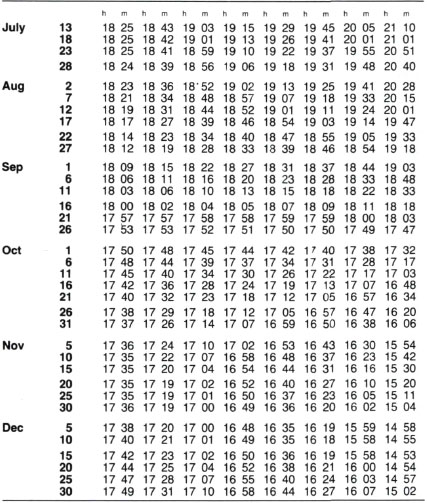POSITIONS OF SUN AND PLANETS, 1998-2005
The table here lists the celestial longitudes of the Sun and naked eye planets. For a definition of celestial longitude, refer to here. To find where, among the constellations, the planets will be, plot the given longitudes on the sky map on the facing page. Remember that the planets can lie as much as a few degrees north or south of the ecliptic, but the positions given are close enough for locating them. The Sun is, of course, always on the ecliptic. Planets are invisible at times because of nearness to the Sun.
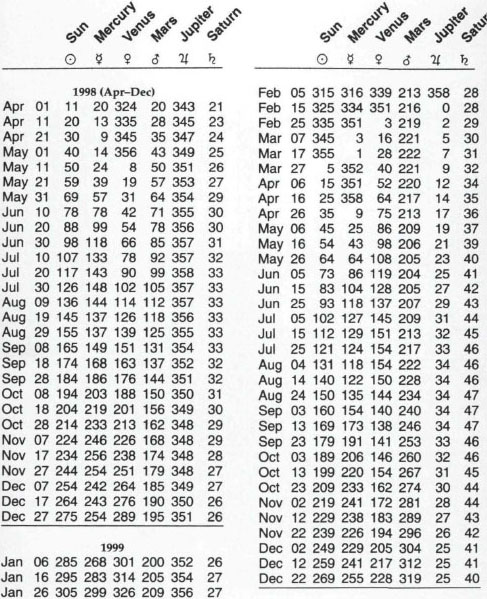
PLANETARY SATELLITES DATA
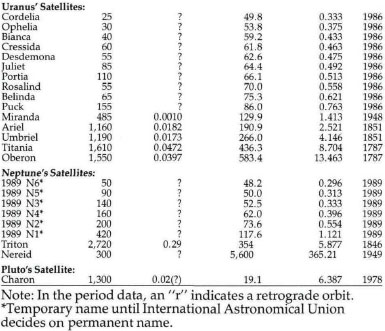
PHASES OF THE MOON, 1998-2006
Data in the table are given in Greenwich Mean Time. To convert to time zones in use in the United States, from the times given subtract:
4h to get Eastern Daylight Time
5h to get Eastern Standard or Central Daylight Time
6h to get Central Standard or Mountain Daylight Time
7h to get Mountain Standard or Pacific Daylight Time
8h to get Pacific Standard Time
If the number of hours to be subtracted is greater than the number of hours in the table, add 24h to the time in the table before subtracting. In that case, the date of the event is one day before the date given in the table. For example, if a full moon occurs at 04h30m GMT on June 15, it will occur at 23h30m EST on June 14. Simply remember what time zone you are in when making your calculation. For conversion to other zones, see here.

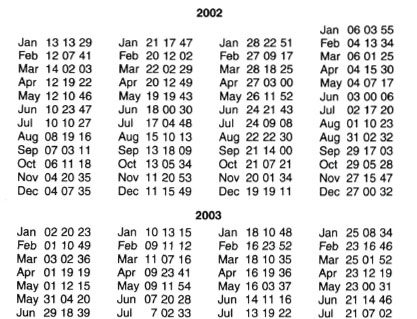
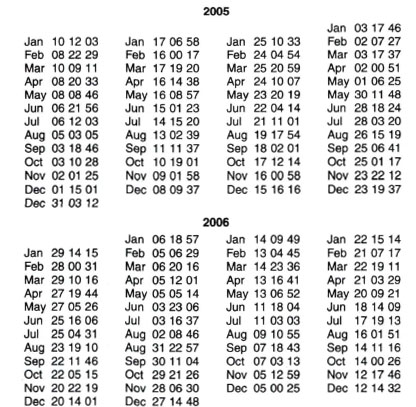
TIMES OF SUNSET AND SUNRISE
Data in the following tables is given in approximate Local Mean Time (LMT). To convert to your zone time, follow the instructions in the next-to-last paragraph here.
SUNRISE
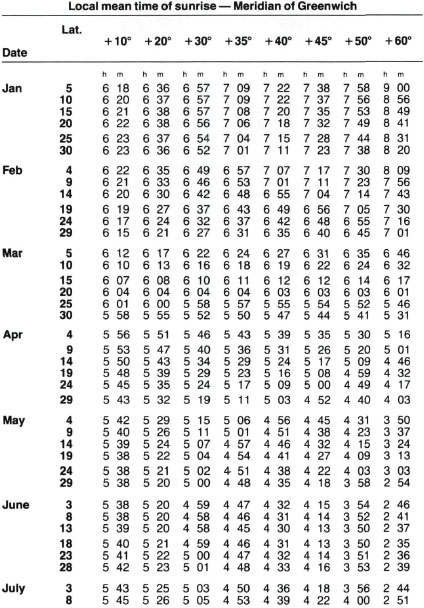
SOME MAJOR PLANETARIUMS
For a more extensive list, and more information about planetariums, consult the references given on the following page.
Talbert and Leota Abrams Planetarium
Science Road
Michigan State University
East Lansing, Michigan 48824
(517)355-4673
Adler Planetarium
1300 South Lake Shore Drive
Chicago, Illinois 60605
(312) 322-0304
American Museum-Hayden Planetarium
81st Street at Central Park West
New York, New York 10024
(212)873-8828
Buhl Planetarium
Allegheny Square
Pittsburgh, Pennsylvania 15212
(412) 321-4300
Davis Planetarium
Maryland Science Center
601 Light Street
Baltimore, Maryland 21230
(301) 685-2370
R. C. Davis Planetarium
P.O. Box 288
Jackson, Mississippi 39205
(601)969-6888
Albert Einstein Spacearium
National Air and Space Museum
6th and Independence Avenue
Washington, D.C. 20560
(202) 381-4193
Fels Planetarium
20th and Parkway
Philadelphia, Pennsylvania 19103
(215) 448-1292
Fernbank Science Center Planetarium
156 Heaton Park Drive
Atlanta, Georgia 30307
(404) 378-4311
Grace H. Flandrau Planetarium
University of Arizona
Tucson, Arizona 85721
(602) 626-4515
Reuben H. Fleet Space Theater
1875 El Prado
San Diego, California 92103
(714) 238-1233
Gates Planetarium
Colorado Boulevard and Montview
Denver, Colorado 80205
(303) 388-4201
Griffith Observatory
2800 East Observatory Road
Los Angeles, California 90027
(213) 664-1181
George T. Hansen Planetarium
15 South State Street
Salt Lake City, Utah 84111
(801)364-3611
Charles Hayden Planetarium
Museum of Science
Boston, Massachusetts 02114
(617)723-2500
Louisiana Arts and Science Center Planetarium
502 North Boulevard
Baton Rouge, Louisiana 70802
(504) 344-9465
McDonnell Planetarium
5100 Clayton Avenue
St. Louis, Missouri 63110
(314) 535-5811
Morehead Planetarium
University of North Carolina
Chapel Hill, North Carolina 27514
(919) 933-1237
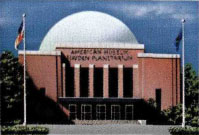
Morrison Planetarium
California Academy of Sciences
Golden Gate Park
San Francisco, California 94118
(415) 221-5100
Space Transit Planetarium
3280 South Miami Avenue
Miami, Florida 33129
(305) 854-4242
Strasenburgh Planetarium
663 East Avenue
Rochester, New York 14607
(716) 271-4320
Vanderbilt Planetarium
178 Little Neck Road
Centerport, New York 11721
(516) 262-7800
OBSERVATORIES
The following is a list of some observatories in the United States that are occasionally open to the public for lectures, public viewing, or tours. For a more complete list, see U.S. Observatories: A Directory and Travel Guide by H. T. Kirby-Smith, Van Nostrand Reinhold Company, New York, 1976.
Allegheny Observatory
Department of Physics and Astronomy
University of Pittsburgh
Pittsburgh, Pennsylvania 15214
(412) 624-4290
Hale Observatories (Mt. Wilson and Mt. Palomar)
California Institute of Technology
Pasadena, California 91101
Harvard-Smithsonian Center for Astrophysics
“Open Nights”
Center for Astrophysics
60 Garden Street
Cambridge, Massachusetts 02138
(617)495-7000
Kitt Peak National Observatory
P.O. Box 26732
Tucson, Arizona 85726
(602) 325-9204
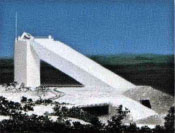
Lick Observatory
Department of Astronomy
University of California at Santa Cru
Santa Cruz, California 95064
(408)429-2513
McDonald Observatory
Department of Astronomy
University of Texas
Austin, Texas 78712
(512) 471-4462
National Radio and Ionospheric Observatory (Puerto Rico)
P. O. Box 995
Arecibo, Puerto Rico 00612
(809) 878-2612
National Radio Astronomy Observatory
Charlottesville, Virginia 22901
(804) 296-0211
Sproul Observatory
Swarthmore College
Swarthmore, Pennsylvania 19081
(215) 544-7900 Ext. 207
United States Naval Observatory
Washington, D.C. 20390
(202) 254-4533
Yerkes Observatory
University of Chicago
Chicago, Illinois 60637
(312) 753-8180

